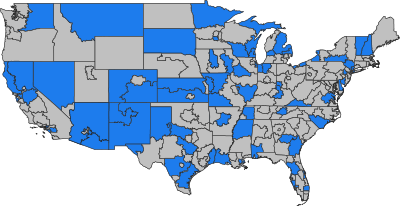
The North American Numbering Plan (NANP) is a telephone numbering plan for twenty-five regions in twenty countries, primarily in North America and the Caribbean. This group is historically known as World Zone 1 and has the telephone country code 1. Some North American countries, most notably Mexico, do not participate in the NANP.

Area codes 314 and 557 are telephone area codes in the North American Numbering Plan (NANP) in the U.S. state of Missouri, serving the city of St. Louis and most of its inner-ring suburbs in neighboring St. Louis County. The numbering plan area is bordered to the west by area code 636, which serves St. Louis' outer suburbs to the west, south, and north. Across the Mississippi River to the east, 314 is adjacent to area code 618, which serves southern Illinois and most of Metro East. Area code 557 was added to the 314 numbering plan area on August 12, 2022, to form an overlay numbering plan.
Seven-digit dialing is a telephone dialing procedure customary in some territories of the North American Numbering Plan (NANP) for dialing telephone numbers in the same numbering plan area (NPA). NANP telephone numbers consist of ten digits, of which the leading three are the area code. In seven-digit dialing it is not necessary to dial the area code. The procedure is also sometimes known as local format or network format.
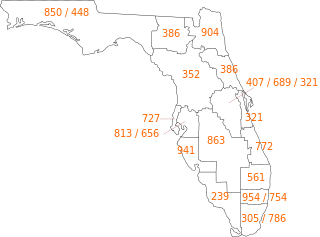
Area codes 561 and 728 are telephone area codes in the North American Numbering Plan (NANP) for Palm Beach County in the U.S. state of Florida. 561 was created on May 13, 1996, in a split of area code 407. The numbering plan area (NPA) comprises nearly every major city in the county, the largest of which being West Palm Beach, Boca Raton, Wellington, Boynton Beach, Jupiter, Delray Beach, and Belle Glade. On March 10, 2023, area code 728 was added to the same numbering plan area to form an all-services distributed overlay.

Area codes 920 and 274 are telephone area codes in the North American Numbering Plan (NANP) for a large area of eastern Wisconsin. Area code 920 was created on July 26, 1997, in a split of area code 414, one of the original North American area codes of 1947. 274 was added to the same numbering plan area (NPA) on May 5, 2023 to create an area code overlay.

Area codes 516 and 363 are telephone overlay area codes in the North American Numbering Plan (NANP) for the U.S. state of New York. The numbering plan area (NPA) comprises Nassau County on Long Island. Area code 516 was created in 1951 and 363 was added to the numbering plan area in 2023.

Area code 804 is the telephone area code in the North American Numbering Plan (NANP) for the east-central portion of Virginia. The numbering plan area is anchored by Virginia's capital, Richmond, and includes most of its metropolitan area. Other communities included are Chesterfield, Henrico, Hopewell, Mechanicsville, Powhatan, Midlothian, Petersburg, and Colonial Heights. This also includes the Northern Neck and the Middle Peninsula. The two southernmost counties on the Middle Peninsula, Gloucester and Mathews, are part of the Hampton Roads metropolitan area, but use 804 instead of the area code 757 used by the rest of Hampton Roads.

Area codes 202 and 771 are telephone area codes in the North American Numbering Plan (NANP) for Washington, D.C.

Area codes 608 and 353 are telephone area codes in the North American Numbering Plan for much of southwestern Wisconsin, including the state capital city Madison. Area code 608 was assigned in 1955 to a numbering plan area created from areas with area code 414 and area code 715, and was the third area code created in Wisconsin. Rapid growth of the area, specifically in Dane County, brought the area code close to exhaustion of central office prefixes, with NANPA projections in 2022 projecting the need for relief by late 2023. In September 2022, the Wisconsin Public Service Commission and North American Numbering Plan Administrator (NANPA) announced an overlay complex for the numbering plan area with new area code 353, with an in-service date of September 15, 2023. New central office code orders were accepted starting on July 11, 2023, but activatlon is contingent on complete exhaustion of central office codes for 608.
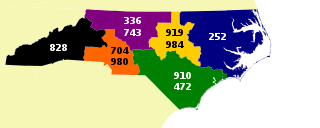
Area codes 910 and 472 are telephone area codes in the North American Numbering Plan (NANP) for southeastern North Carolina. The area codes form an overlay for a numbering plan area (NPA) that includes the cities of Wilmington, Jacksonville, Laurinburg, Lumberton and Fayetteville. Area code 910 was established in 1993, and 472 was added to the same area in October 2022.

Area codes 602, 480, and 623 are telephone area codes in the North American Numbering Plan (NANP) for most of the Phoenix metropolitan area in the U.S. state of Arizona.

Area codes 678, 470, and 943 are telephone area codes in the North American Numbering Plan (NANP) for the U.S. State of Georgia in the Atlanta metropolitan area. The area codes are assigned in an overlay plan to a combined numbering plan area (NPA) consisting of 404 and 770.

Area code 319 is a telephone area code in the North American Numbering Plan (NANP) for the southeastern and east-central parts of the U.S. state of Iowa.
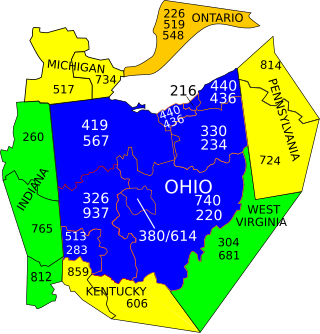
Area codes 513 and 283 are telephone area codes in the North American Numbering Plan (NANP) for the southwest of the U.S. state of Ohio, including Cincinnati and surrounding cities, such as Forest Park, Hamilton, Lebanon, West Chester, Mason, Maineville, Middletown, Milford, Norwood, Oxford, Harrison, Cleves, Miamitown and Trenton.

Area code 970 is a telephone area code in the North American Numbering Plan (NANP) for most of the western and northern parts of the U.S. state of Colorado. The numbering plan area includes Aspen, Breckenridge, Durango, Estes Park, Fort Collins, Glenwood Springs, Grand Junction, Greeley, Loveland, Silverthorne, Steamboat Springs, and Vail. It was established on April 2, 1995 in an area code split of area code 303, which was retained by the Denver area.
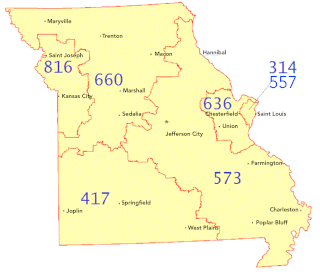
Area codes 816 and 975 are telephone area codes in the North American Numbering Plan (NANP) for most of the Missouri side of the Kansas City metropolitan area, the St. Joseph area, and all or part of 15 surrounding counties in northwestern Missouri. The numbering plan area originally comprised most of the northern and western two-thirds of the state, bordering with Arkansas, Illinois, Iowa, Kansas, Nebraska, and Oklahoma, but has been reduced to a ribbon bordering Kansas. 816 is one of the original 86 area codes created in 1947. The numbering plan area was converted to an overlay complex with area code 975 in 2023.

Area codes 618 and 730 are telephone area codes in the North American Numbering Plan (NANP) for southern Illinois. The numbering plan area (NPA) comprises one hundred and twenty-six municipalities, such as Carbondale, Cairo, Belleville, East St. Louis, Edwardsville, Marion, O'Fallon, Alton, Mt. Vernon, Centralia, Herrin, Salem, Metropolis, Fairview Heights, Collinsville, and Granite City. Area code 618 was one of the original North American area codes created in 1947, and 730 was added to the plan area to form an overlay complex to satisfy the need for more telephone numbers in the region.

Area code 440 and 436 is a telephone area code in the North American Numbering Plan (NANP) for the U.S. state of Ohio, serving the parts of the Greater Cleveland area, surrounding the city of Cleveland, but not the city and most of its inner suburbs.

Area code 864 is a telephone area code in the North American Numbering Plan (NANP) for the U.S. state of South Carolina. The numbering plan area (NPA) comprises the areas of Greenville, Spartanburg, Anderson, and twelve surrounding counties in upstate South Carolina. Other cities in the 864 territory include Clemson, Gaffney, Greer, and Mauldin.

The 988 Suicide & Crisis Lifeline is a suicide prevention network of over two hundred crisis centers in the United States that provides 24/7 service via a toll-free hotline with the telephone number 9-8-8. It is available to anyone in suicidal crisis or emotional distress. The call is routed to the nearest crisis center to receive immediate counseling and local mental health referrals. The Lifeline supports people who call for their own crisis or for someone they care about.
